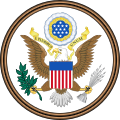Seventh Party System
The Seventh Party System is a proposed era of American politics that began sometime around the 2010s or 2020s. Its periodization, alongside the Sixth Party System, is heavily debated due to the lack of an overwhelming change of hands in Congress since the end of the New Deal Party System. Dating the Seventh Party SystemTheories as to the beginning date of the Seventh Party system range from 2008 to 2020.[citation needed] Political scientists Mark D. Brewer and L. Sandy Maisel saying, "In the wake of Donald Trump's 2016 presidential victory, there is now strengthening debate as to whether [the United States is] entering a new party system as Trump fundamentally reshapes the Republican Party and the Democratic Party responds and evolves as well."[1] Donald Trump's 2024 re-election has led to major speculation and discussions on a potential political realignment due to voter demographic shifts.[2] Trump's victories in all swing states, dominance with white working-class voters, and historic Republican gains with Hispanics, Blacks, and Asians have produced conversations on the emergence of the Seventh Party system in the American landscape. For example, in Florida’s Miami-Dade County, Trump significantly improved his margins among Hispanic voters in 2020 compared to 2016.[3] In Texas’s Rio Grande Valley, Republicans increased their support among predominantly Latino counties and Zapata county (population less than 15,000) was the only county in South Texas that flipped red for the first time in a hundred years,[4] and exit polls nationwide indicated increases in Trump’s support among Hispanic voters during the 2020 presidential election.[5] Stating in 2025 that "'The Age of Trump' Enters Its Second Decade", Peter Baker of The New York Times wrote "In those 10 years, Mr. Trump has come to define his age in a way rarely seen in America, more so than any president of the past century other than Franklin D. Roosevelt and Ronald Reagan".[6] The Republican Party has also made a decisive shift away from free trade to advocating for protectionism, a historic Republican position that has since been revived by Trump. Trump cited President William McKinley as a political hero, noting his McKinley Tariff as a blueprint for protectionist industrial policy. As of August 2025, the United States currently has the highest effective tariff rate since 1935. This shift has increasingly forced the rival Democratic Party to become increasingly positive towards free trade, replicating the divide of the late 19th and early twentieth century on trade policy.[7] Characteristics of the proposed Seventh Party SystemProponents of the shift to the Seventh Party System note several recent shifts in demographics and voting patterns. Non-white voters, who historically have predominantly voted Democratic, have grown as a share of the population since the start of the Sixth Party System, and previously Republican-leaning secular college-educated white voters have moved to the left. At the same time, Republicans have made significant inroads with white voters without a college degree, while maintaining their favor with evangelical Christian voters.[8][9] See also
Notes
References
|
|||||||||||||||||
















